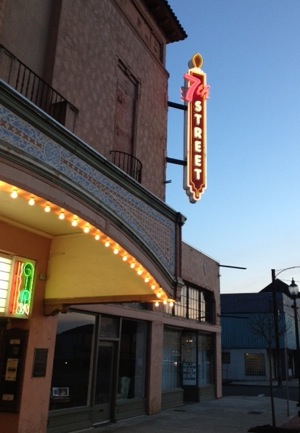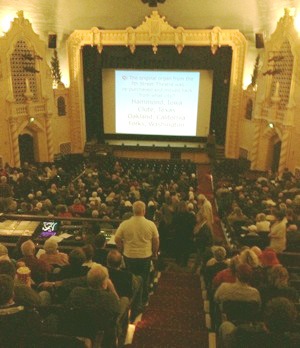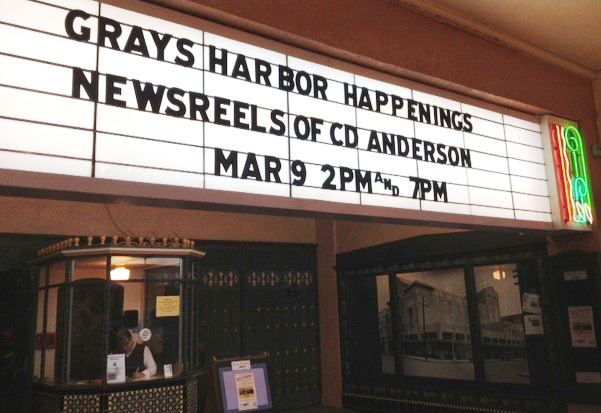Click here to print
Amateur Newsreel Footage Brings It Home
posted April 22, 2013
By Rachel Price
n
n
Grays Harbor County, in the far western part of Washington state is, at this moment, drawing thousands of visitors to its shore, there to gawk at scores of migrating shorebirds refueling in the coastal mud flats. Last month, I braved Interstate 5 from Seattle to head out to the area for a different reason—to watch creatures of the human variety, in amateur newsreels from the 1920s filmed in this area when it was a thriving and populated logging community.

Little is known about the newsreel filmmaker C.D. Anderson, of Anderson Photo Art and Commercial Photography, and there generally isn’t much amateur newsreel footage of any region known to still exist, according to University of Washington film preservationist Hannah Palin, who restored the newsreels. If you’ve heard of the Electronic Edwardians or The Kidnapper’s Foil, you know there was a time when filmmakers captured local citizens at town events like parades and picnics or, in the case of The Kidnapper’s Foil, local kids of a town acted out a scripted scenario that was filmed. In all cases, these citizens were meant to see themselves later on film. John Hughes, the chief historian of the Washington State Heritage Center, said the town had three daily newspapers and a dozen photo studios at that time, and was a “sawdust aristocracy” resulting from the area’s logging renown. It was the logs of this area that supplied San Francisco after its 1906 earthquake.
 The 35mm nitrate footage of Aberdeen, Hoquiam, and surrounding Grays Harbor County was uncovered a few years ago in a cardboard box at a commercial storage space in Seattle and donated to University of Washington Libraries Special Collections. That Saturday in Hoquiam, a fine and moving documentary about the find, which Ann Coppel made for UWTV, featured choice clips of the newsreels along with interviews with folks explaining its value. As the preserved footage screened Saturday, it was charmingly and informatively narrated by young local historians – John Larson, director of the Polson Museum, and researcher Roy Vataja from the Aberdeen Museum of History. Vataja logged many hours viewing newspapers on a microfilm machine, coming across “Screen to Show Harbor Events,” in the Aberdeen Daily World article, September 17, 1925. From the article: “It is expected that the new project will be well-liked by the theater-going population of the city as Harbor theater managers say that news reels are among the most popular of the extra attraction shown.”
The 35mm nitrate footage of Aberdeen, Hoquiam, and surrounding Grays Harbor County was uncovered a few years ago in a cardboard box at a commercial storage space in Seattle and donated to University of Washington Libraries Special Collections. That Saturday in Hoquiam, a fine and moving documentary about the find, which Ann Coppel made for UWTV, featured choice clips of the newsreels along with interviews with folks explaining its value. As the preserved footage screened Saturday, it was charmingly and informatively narrated by young local historians – John Larson, director of the Polson Museum, and researcher Roy Vataja from the Aberdeen Museum of History. Vataja logged many hours viewing newspapers on a microfilm machine, coming across “Screen to Show Harbor Events,” in the Aberdeen Daily World article, September 17, 1925. From the article: “It is expected that the new project will be well-liked by the theater-going population of the city as Harbor theater managers say that news reels are among the most popular of the extra attraction shown.”
The collection in its entirety can be viewed online in its digital surrogate. (To view individual segments, click Browse Collection, off to the right.) Once there, you may want to watch the Aberdeen Black Cats win the Timber League pennant, parades and county fairs, football games and log rolling, and an incredible BBQ pit and picnic that could safely be described as both non-wasteful—it’s not clear what wasn’t eaten—and gluttonous.
 An unusual segment featured a sponsored, public wedding that took place at the 1926 Grays Harbor County Fair. Vataja, in his research, learned that dozens of businesses pledged to contribute merchandise to the nuptials. Stores like Zimmer Hardware, the Golden Rule Department Store, High Lead Cigar Store, the Payette Music House, and Café Huber were among those donating shoes, dinner, theater tickets, bath trimmings, bacon, a sewing cabinet, records, and a piano lamp to the shy couple.
An unusual segment featured a sponsored, public wedding that took place at the 1926 Grays Harbor County Fair. Vataja, in his research, learned that dozens of businesses pledged to contribute merchandise to the nuptials. Stores like Zimmer Hardware, the Golden Rule Department Store, High Lead Cigar Store, the Payette Music House, and Café Huber were among those donating shoes, dinner, theater tickets, bath trimmings, bacon, a sewing cabinet, records, and a piano lamp to the shy couple.

As the Hoquiam mayor concluded his introductory remarks before the evening screening, he said the local ghost-hunting group had been doing their ghost inventories of the area’s old buildings. During a recent “reading” of the local Elks club, the group claimed they had some ghostly visitors normally only associated with the 7th Street Theater. These double-duty ghosts were perhaps gearing up for being asked to move over for paying patrons that Saturday night in Hoquiam. We thank them for it.
Printed from Moving Image Archive News: http://www.movingimagearchivenews.org
URL to article: http://www.movingimagearchivenews.org/amateur-newsreel-footage-brings-it-home/
Click here to print
